How to Grill Chicken Thighs: Temps for Superior Chicken
Chicken is indisputably America’s favorite meat by pound consumed. And one of the easiest, best, and cheapest ways to cook chicken is to grill boneless skinless chicken thighs. They’re incredibly forgiving, which is good for a high-heat environment like a grill, and produce out-size tastiness for the. In this post, we’ll go over the how’s and why’s of grilling chicken thighs, with special attention paid to the thermal processes so that you can have an understanding of what’s happening, not just a set of instructions. Let’s get to it.
Get the tool you need to cook this right:
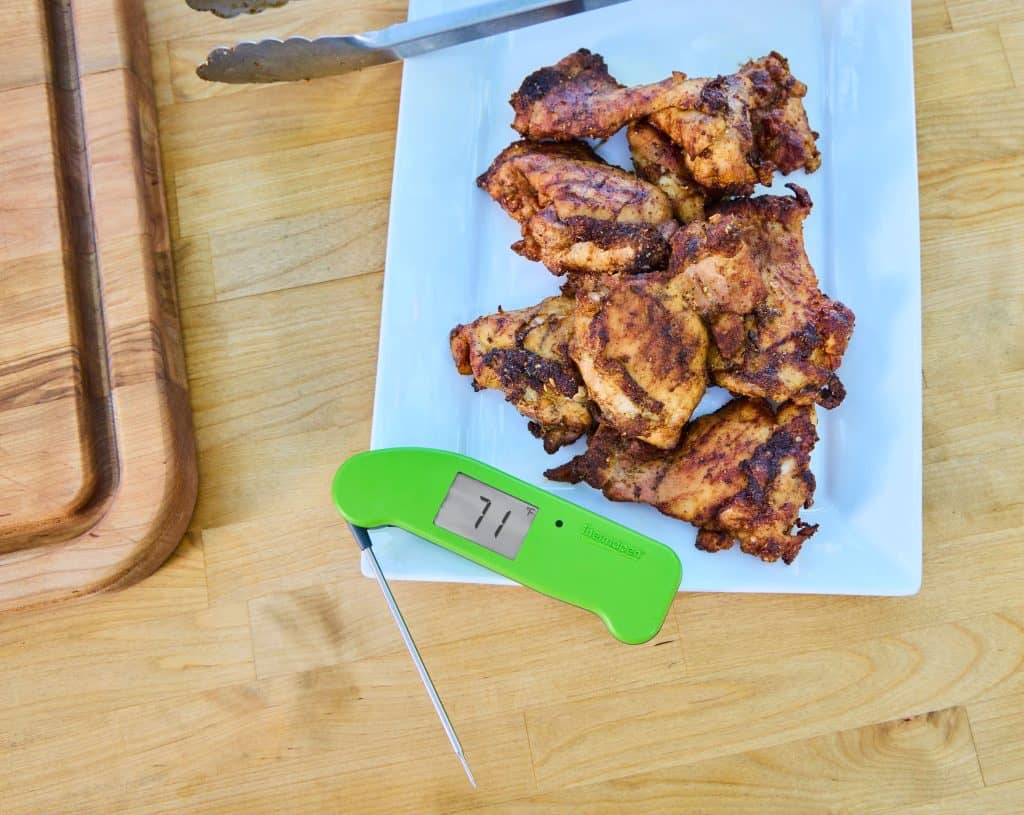
Initial concerns: why chicken breast is terrible, not delicious
First off, we hear you. Many people have the idea that chicken breast is the most tender and juicy meat on the bird. They are wrong. It’s not their fault—marketing has worked hard to make sure they think so. All those commercials with delicious-looking chicken sandwiches from various restaurants, each claiming the juiciest meat, have ingrained in the American mind the fantasy of perfect chicken breast meat. And while it is possible, it’s also difficult. Chicken breast is composed of muscles that are not well used, evolutionarily speaking, by the chicken, so they are tender by nature—much like a filet mignon steak is tender by nature.
The difference? We almost never (or at least should never) cook a steak to the point where its protein fibers clamp up and expel all their water. That’s because we don’t think of rare-cooked beef as being as dangerous as rare-cooked chicken. But by the time we cook chicken breast to the point where it’s “safe,” we’ve either completely dried it out or we’ve come close enough to finish the job during carryover.
Yes, you can make juicy chicken breasts, but it’s tenuous.
Why thigh is better than breast for the grill
Cooking chicken breast is like a game of golf— you use careful strokes, leading to a tiny goal that is easy to miss even when you know what you’re doing. Cooking thigh is more like a football game—the endzone is large, and there’s more than one way of scoring points. Yes, there is still skill involved, yes precision is still needed. But the very nature of the goal changes how we can approach it and what is required to achieve success.
Because of the connective tissue present in chicken thigh, it has to be cooked to a higher temperature than breast does. Not for the sake of safety, but for the sake of tasty. The energy-storing proteins and collagen in chicken thighs need to be cooked to at least 175°F (79°C) to break down into tenderer gelatin, which helps to retain moisture. As Harold McGee says, with the breakdown of those connective tissues, the meat goes from tough to tender and the gelatin provides succulence to the meat. (the breakdown of collagen starts at a lower temp, but you don’t usually get enough of that happening until the higher 175°F [79°C] temp.)
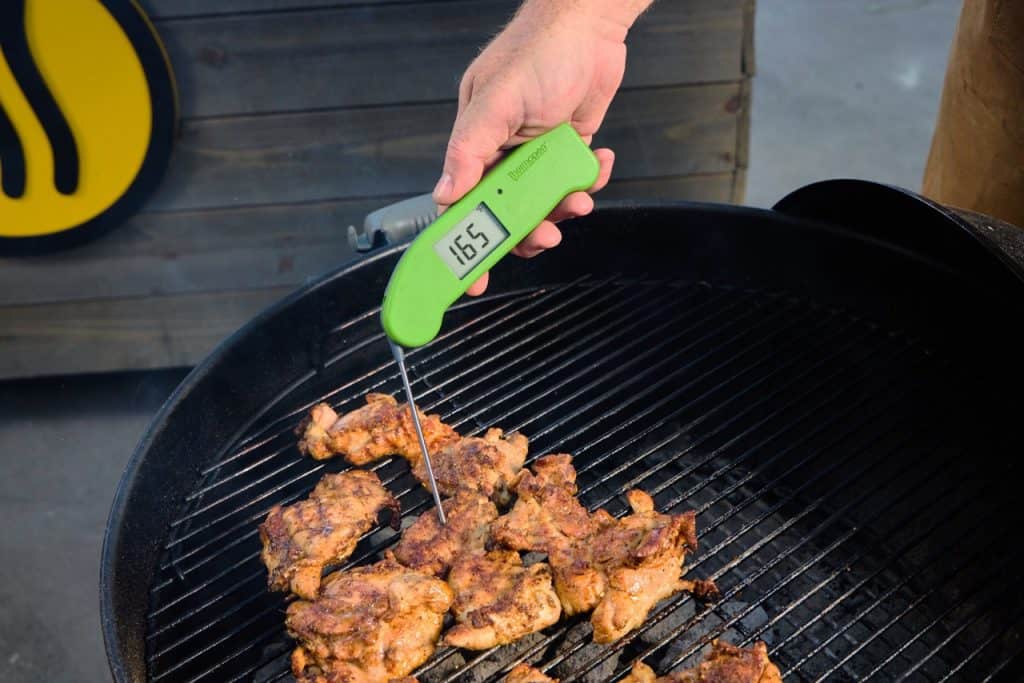
Because the grill is a high-heat, direct-cooking environment, we want meat that can take a little more thermal abuse. Higher heat means there will be more carryover, but our “wider endzone goal” of 175–200°F (79–93°C) means we don’t have to try to predict an exact amount of carryover to plan for so that we can predict when to remove the meat from the grill. We can cook it all the way to 175°F (79°C), remove it from heat, and not worry that another 20°F (11°C) will overcook it. It will certainly get hotter, but it won’t hurt it because until we reach the top temp of about 200°F (93°C), we’re not losing tenderness or even that much juiciness. That means you can push the “grilled” flavor further without ruining dinner.
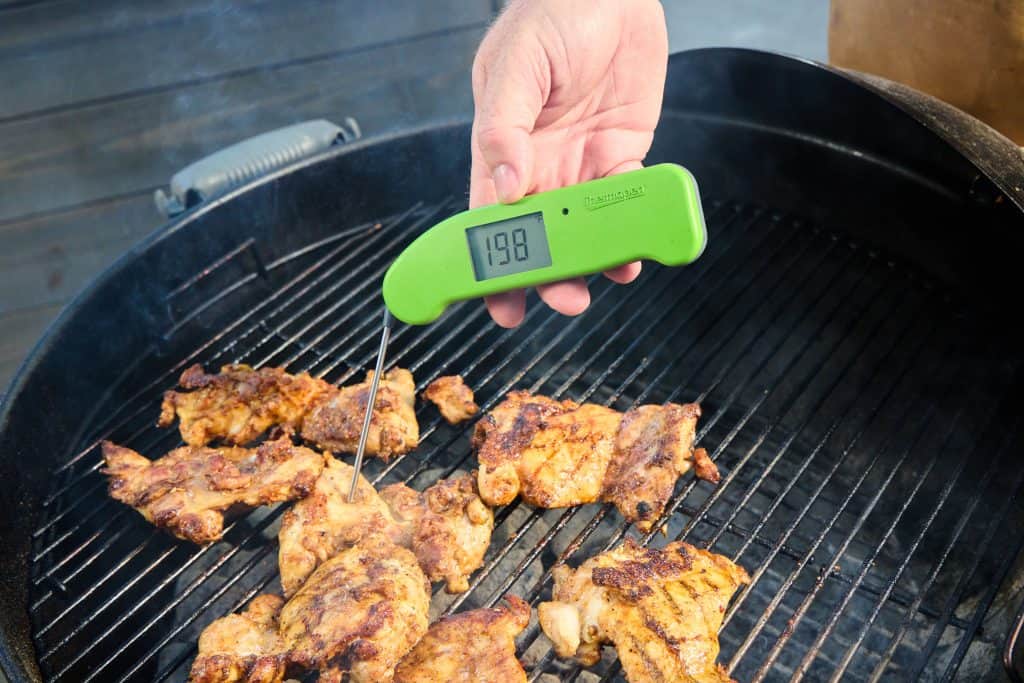
When we cook chicken thighs properly, to this higher temperature, we end up with chicken that is every bit as tender and juicy as the best breasts, but we do so far more easily and successfully.
How to grill chicken thighs
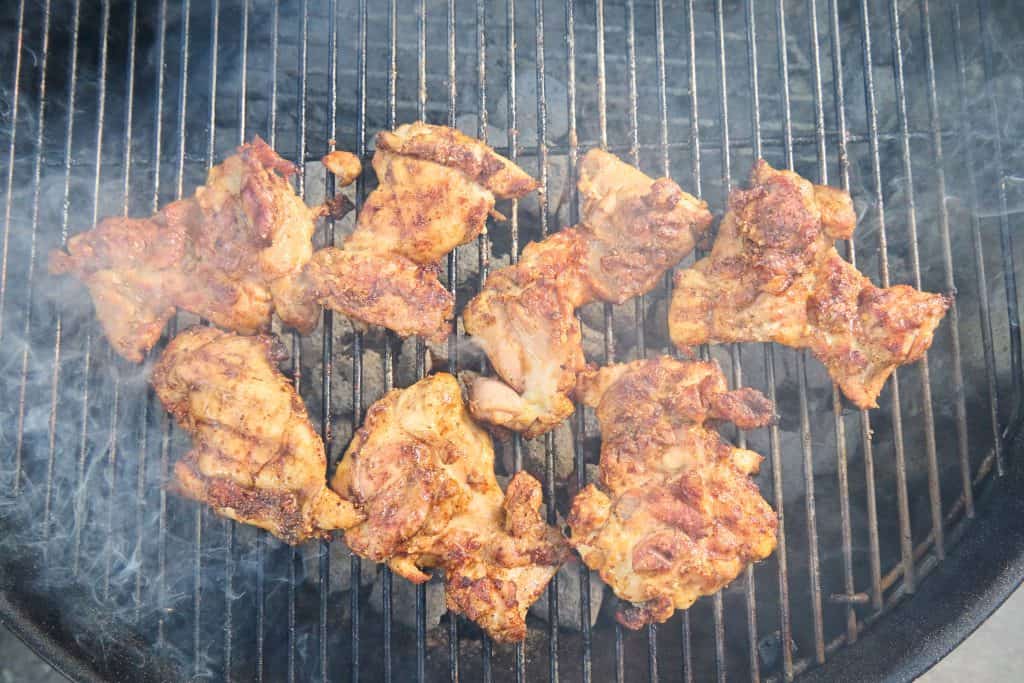
Our main focus here is boneless, skinless chicken thighs. They are cheap, readily available, and cook up quickly. They can be adapted to almost any recipe and are by far one of our favorite things to cook when we just need some protein with dinner. That being said, the concepts apply to bone-in chicken thighs as well, they just take longer to cook because of their geometry—they are closer to spherical and will therefore cook more slowly due to their lack of surface area.
Setting up your grill for grilling chicken thighs
You don’t need a two-zone setup for thighs. You can just have your layer of coals (or gas burners) a few inches below the grates. We don’t need to gentle-cook anything, per se, so a cool zone isn’t necessary. The heat we want is about equivalent to one layer of coals in the fuel section of a Weber Kettle grill. Any deeper/hotter than that and the cooking is less fun, though still completely possible.
Seasoning your chicken thighs
You do you here! We recommend using some oil as you mix your seasonings in with the chicken—if you’re using dry seasonings. (If you marinate in wet seasonings, it isn’t necessary.) Make the most out of the blank slate that chicken thighs present. For the cook in the pictures on this post, we used salt, pepper, red pepper, and some Szechuan peppercorn, but we could just as easily have used shawarma seasoning, jerk seasoning, or any of 50 BBQ rubs in the cupboard. Just use what you’ll like and what will match the rest of your food.
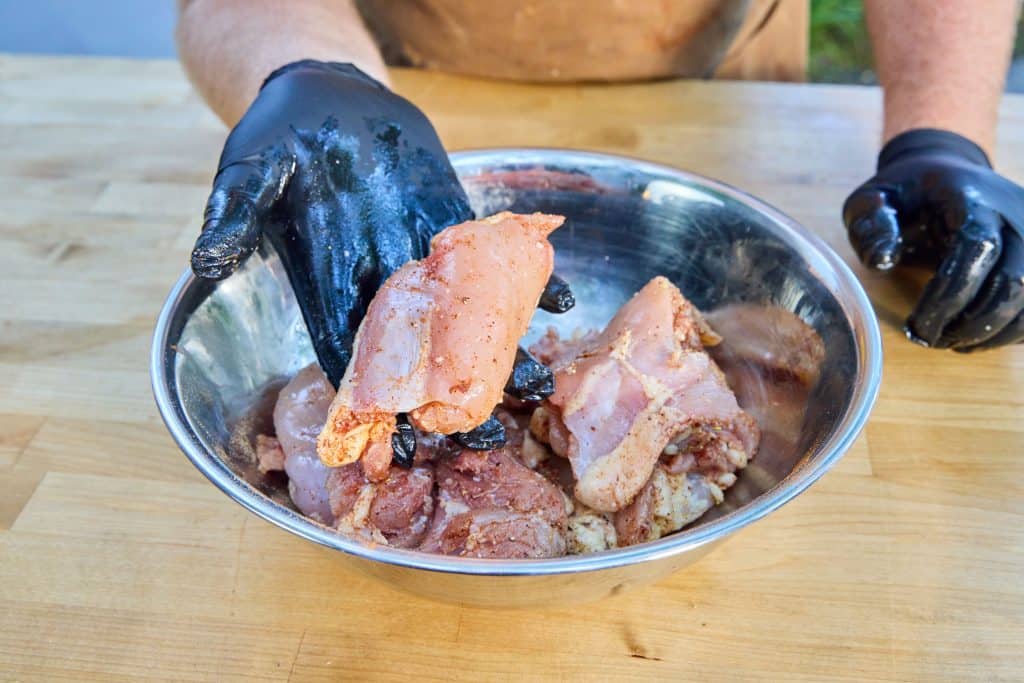
(As you season the thighs, check for bone fragments that are left behind from processing. They’re easy to find with your fingers and terrible to find later on with your mouth.)
Grilling chicken thighs
Once your thighs are oiled and seasoned, lay them out on the grill and let them start cooking over the coals. Turn them every couple of minutes to get even grill flavor all over and to prevent burning. (Yes, there is a wide temperature latitude, but burnt is still burnt!) Use your Thermapen ONE (in our analogy, the skilled and precise quarterback that is throwing for the touchdown) to test the temperatures regularly. You’ll find that some thighs cook faster, some slower—that hot and cold spots abound on your grill. Make use of that, and move the chicken around so that it all cooks at about the same rate.
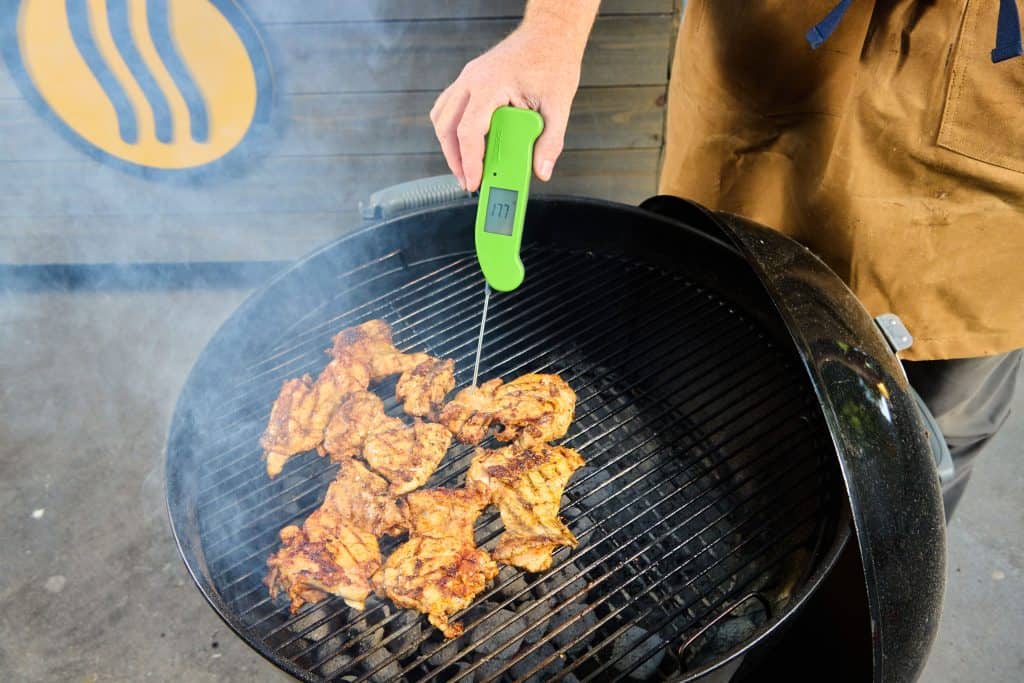
When you tempt the thighs, do so in multiple places. It will be obvious that there is a thick and a thin part of the meat, and you’ll want to make sure that you don’t find any temps below that threshold of 175°F (79°C). As you find pieces that are done, move them either off the grill or into a cool spot on the grill where they won’t keep cooking.
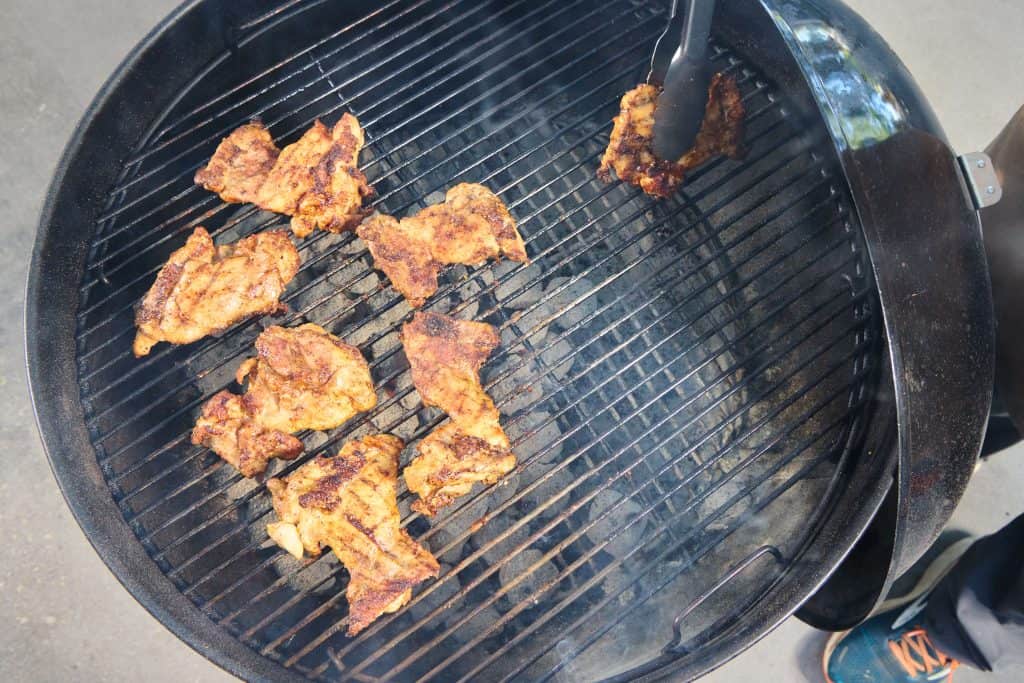
Serving grilled chicken thighs
You can serve these right from the grill without a need to rest, really. Either sling them whole for your diners to cut up, or chop them up to stuff into pitas, wrap in tortillas, lay on rice, or (*gasp*) top a salad. Honestly, when we made these, we ate most of them with our fingers standing around the photography table. That’s how good grilled chicken thighs are! So go get some. Save yourself the bother of trying to get chicken breasts just right. Get out your thermapen, and use it to land perfect chicken thighs on your plate every single time with a minimum of effort. Happy cooking!
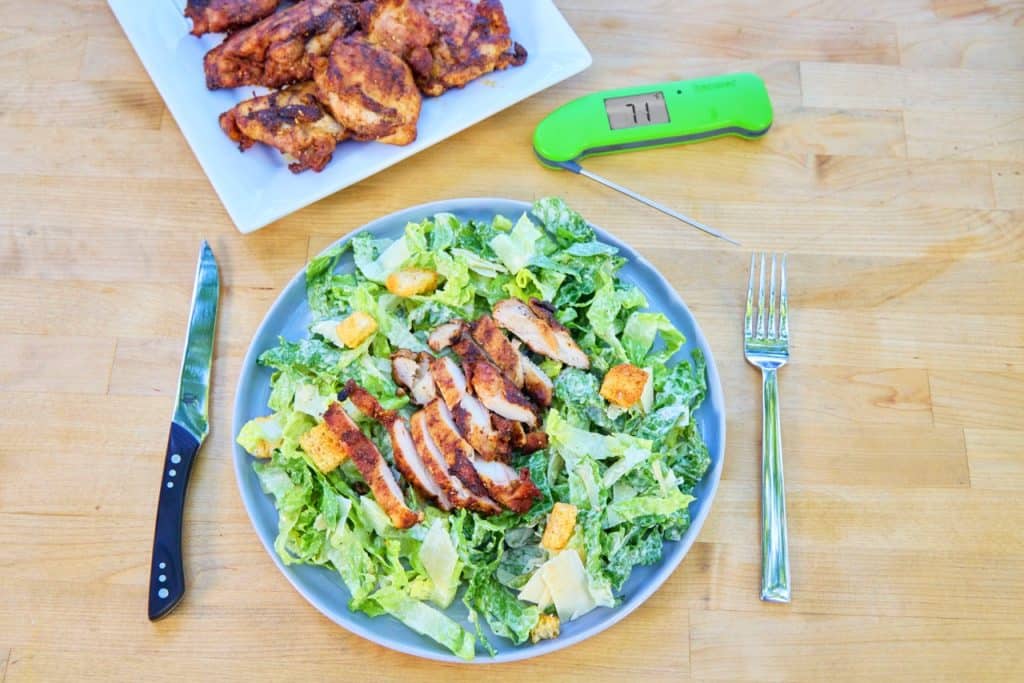


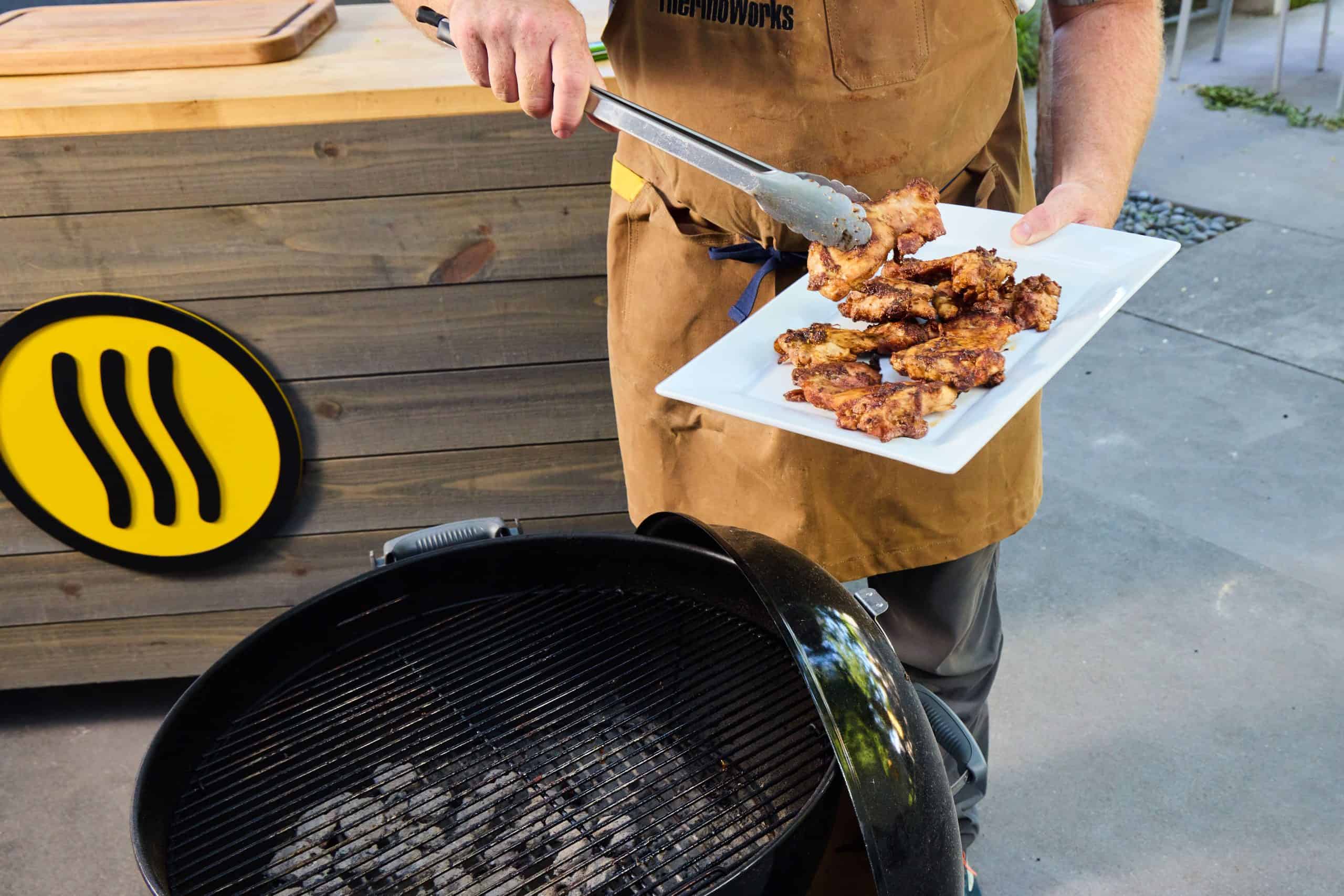

I have used the same method for tempting thighs for years.
Totally agree about thighs,but try using bone-in ones instead. They can be a little cheaper, and the marrow/bone instills a much richer taste in the grilling.The meat pretty much falls off the bone anyway, so not much gained with boneless. I also skin mine to reduce fat, but that’s optional.
Also, thighs match perfectly with tart, Carolina-style, mustard-based BBQ sauce. Marinate them liberally before you grill (a whole day before in a covered casserole dish in the fridge isn’t too much,) and then lather more on after they’re done. Add a nice salad, and you’ve got the perfect summer meal. (Or winter. I do them all year ’round.)
So good, your eyebrows will fall off.
I always grill my thighs using indirect heat. I use bone-in, skin-on thighs brushed with oil and salted. Kosher only. Removed at 200 degrees both the taste and presentation is impeccable!